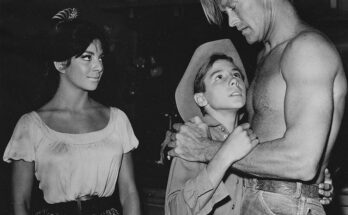Imagine being just eight years old and already creating a masterpiece that would go on to captivate the hearts of millions worldwide. That’s exactly what happened to Akiane Kramarik, a young prodigy with an extraordinary gift for art and an even more extraordinary story. At an age when most children are still discovering their basic artistic abilities, Akiane painted a portrait that she claimed was not born from imagination or traditional teachings, but from something far more mysterious: a divine vision.
Her painting, titled “Prince of Peace,” is a mesmerizing portrayal of Jesus Christ, rendered with such depth, emotion, and technical skill that it stunned the art community. But what truly sets this story apart is not just the sheer talent displayed by a child artist. It’s the narrative behind the artwork—the claim that she was painting a face she had seen, a face that she believed to be the true likeness of Jesus, revealed to her through a series of spiritual experiences.
Now 28 years old, Akiane’s journey from child prodigy to internationally acclaimed artist and author has been anything but ordinary. The story of “Prince of Peace” is filled with twists and turns that could rival any fiction novel, including a mysterious theft, years of legal battles, and an almost miraculous recovery that allowed the painting to finally be displayed again for the public.
An Unlikely Awakening: The Vision of an 8-Year-Old
Born and raised in a secular household in rural Idaho, Akiane’s upbringing was far removed from the spiritual world she would later claim to have experienced. Her parents, Forelli and Mark Kramarik, were not religious. They didn’t attend church, pray, or discuss God at home. To them, the sudden spiritual awakening of their daughter was bewildering. Where could these visions be coming from? How could their child, unexposed to religious teachings, start speaking about divine experiences and heavenly encounters?
But Akiane was insistent. At just four years old, she began telling her mother about the vivid, otherworldly visions she was having—images of landscapes, people, and most strikingly, of a gentle figure she believed to be Jesus. It wasn’t just a fleeting curiosity. These images haunted her thoughts and dreams, compelling her to create.
By the time she was eight, the pull was too strong to resist. She felt an overwhelming urge to capture on canvas the face that had appeared so often in her visions. And so, with a paintbrush too large for her small hands and a determination far beyond her years, Akiane began what would become the most famous piece of her early career: the portrait of Jesus, which she titled “Prince of Peace.”
Finding the Face of Jesus: The Carpenter at the Door
But how does an eight-year-old, with limited experience and no formal training, create such a profound depiction of one of the most recognized figures in human history? Akiane’s answer is as enigmatic as it is captivating: “It comes from God. His voice is soft and lovely.”
According to Akiane, she spent countless hours searching for a human model that could embody the face she saw in her visions. She prayed fervently, hoping that God would send her the right person. Then, as if answering her prayers directly, a mysterious carpenter showed up at their door one day. When Akiane saw him, she was filled with an undeniable certainty—this was the face she had been searching for.
“I told my mother that was him,” she recalls. With the carpenter’s permission, she began using him as a live reference for her painting. As she sketched and painted, the figure of Jesus seemed to come alive on the canvas, taking on the compassionate and serene expression that had been etched into her memory.
The result was “Prince of Peace,” a painting so moving that it seemed to transcend mere artistry. It evoked not just admiration, but also a deep, emotional response from those who viewed it. People described feeling a sense of calm, of peace, and even of divine presence when they gazed at the portrait. It was as if Akiane, through her brushstrokes, had managed to channel something inexplicable—something divine.
The Painting’s Disappearance: A Story of Loss and Recovery
Yet, the story of “Prince of Peace” doesn’t end with its completion. Shortly after its creation, the painting was stolen. A tangled web of miscommunication, deceit, and betrayal ensued, resulting in the masterpiece being sold by mistake and disappearing from public view for nearly 16 years. During this time, the painting changed hands multiple times, each new owner unaware of its true value and the saga behind its creation.
For Akiane, the loss of “Prince of Peace” was devastating. It was not just a painting; it was a part of her soul, a piece of her very being that had been ripped away. She fought tirelessly through legal channels, hoping to recover what was rightfully hers, but each attempt seemed more hopeless than the last. Years passed, and it seemed that the painting was lost forever.
Then, almost miraculously, word surfaced that the painting had been found. Through a combination of luck, persistence, and divine intervention (as Akiane herself believes), “Prince of Peace” was finally returned to her. The legal battles were settled, and the painting was placed in the hands of a private collector who understood its significance. Today, it is proudly displayed at the Belóved Gallery in Marble Falls, Texas, where people from all over the world come to see the portrait that has been touched by both controversy and grace.
The Impact of “Prince of Peace” on Faith and Art
For Akiane, the return of the painting was not just a personal victory. It was a validation of her journey, her faith, and the visions that have guided her since childhood. She describes the experience as “surreal,” a reminder of the power of love and the importance of perseverance.
But the painting’s impact goes beyond its creator. “Prince of Peace” has become a symbol of hope and inspiration for countless people. It has sparked conversations about faith, the nature of art, and the possibility of divine intervention in our lives. Some viewers see in it the face of a loving Savior; others see a child’s extraordinary gift. But all agree on one thing: there is something undeniably special about this painting.
The story of “Prince of Peace” is more than just the story of a painting. It is the story of a young girl’s faith, of a family’s unexpected spiritual awakening, and of a world grappling with the mystery of a talent that seems to defy explanation.
Akiane Today: Beyond “Prince of Peace”
Today, Akiane Kramarik is no longer the wide-eyed child prodigy she once was. At 28, she has matured into a seasoned artist, author, and philanthropist, using her platform to advocate for peace, love, and spiritual awareness. She has painted hundreds of pieces, each one imbued with the same ethereal quality that made “Prince of Peace” so captivating. Her work, which ranges from serene landscapes to powerful portraits, continues to draw on the themes of faith, love, and the divine.
But despite all the acclaim, Akiane remains humble, attributing her gift not to her own abilities, but to a higher power. She speaks of her artistic process as a form of prayer, a dialogue with the divine that guides her hand and shapes her creations. “Art is my way of communicating with God,” she says. “It’s my way of expressing what words cannot.”
The Legacy of a Visionary Artist
The rediscovery of “Prince of Peace” has brought Akiane’s name back into the spotlight, but for her, the painting is not just about fame or recognition. It is a testament to the power of faith, perseverance, and love. It is a reminder that sometimes, the greatest gifts come from the most unexpected places—a vision given to a little girl in the middle of Idaho, far from the art capitals of the world, far from the religious institutions that shape our understanding of spirituality.
Akiane’s story is one of mystery, of loss and redemption, and ultimately, of hope. It is a story that reminds us that sometimes, the greatest masterpieces are not born from technique or training, but from a deep and unshakeable belief in something greater than ourselves. And that, perhaps, is what makes “Prince of Peace” truly priceless.


